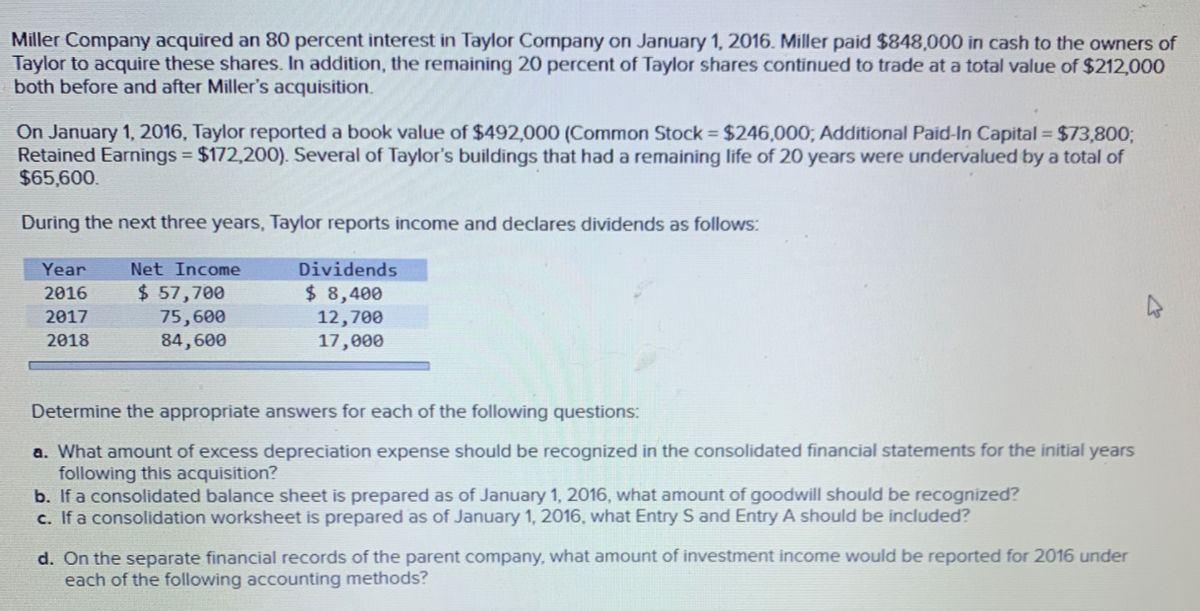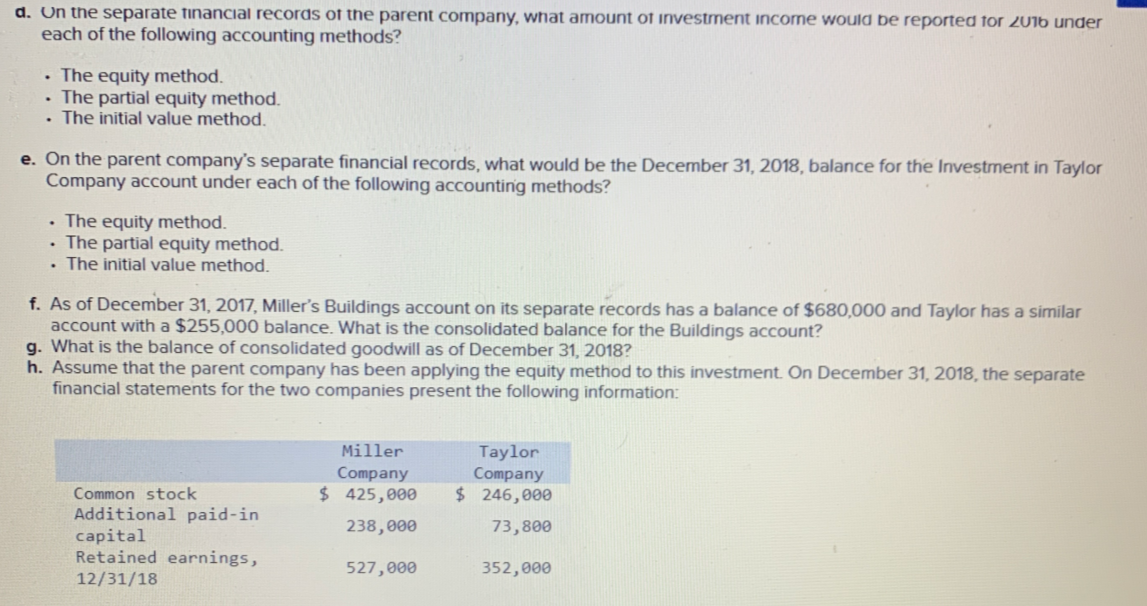Miller Company acquired an 80 percent interest in Taylor Company on January 1, 2016. Miller paid $848,000 in cash to the owners of Taylor to acquire these shares. In addition, the remaining 20 percent of Taylor shares continued to trade at a total value of $212,000 both before and after Miller's acquisition. On January 1, 2016, Taylor reported a book value of $492,000 (Common Stock $246,000; Additional Paid-In Capital = $73,800; Retained Earnings = $172,200). Several of Taylor's buildings that had a remaining life of 20 years were undervalued by a total of $65,600. During the next three years, Taylor reports income and declares dividends as follows: Year Net Income Dividends $ 57,700 $ 8,400 12,700 17,000 2016 2017 75,600 2018 84,600 Determine the appropriate answers for each of the following questions: a. What amount of excess depreciation expense should be recognized in the consolidated financial statements for the initial years following this acquisition? b. If a consolidated balance sheet is prepared as of January 1, 2016, what amount of goodwill should be recognized? c. If a consolidation worksheet is prepared as of January 1, 2016, what Entry S and Entry A should be included? d. On the separate financial records of the parent company, what amount of investment income would be reported for 2016 under each of the following accounting methods? d. On the separate financial records of the parent company, what amount of investrnenit incorne would be reported for 2016 under each of the following accounting methods? • The equity method. • The partial equity method. • The initial value method e. On the parent company's separate financial records, what would be the December 31, 2018, balance for the Ivestment in Taylor Company account under each of the following accounting methods? • The equity method. • The partial equity method. • The initial value method. f. As of December 31, 2017, Miller's Buildings account on its separate records has a balance of $680,000 and Taylor has a similar account with a $255,000 balance. What is the consolidated balance for the Buildings account? g. What is the balance of consolidated goodwill as of December 31, 2018? h. Assume that the parent company has been applying the equity method to this investment. On December 31, 2018, the separate financial statements for the two companies present the following information: Miller Company $ 425,000 Taylor Company $ 246,000 Common stock Additional paid-in capital Retained earnings, 238,000 73,800 527,000 352,000 12/31/18
Miller Company acquired an 80 percent interest in Taylor Company on January 1, 2016. Miller paid $848,000 in cash to the owners of Taylor to acquire these shares. In addition, the remaining 20 percent of Taylor shares continued to trade at a total value of $212,000 both before and after Miller's acquisition. On January 1, 2016, Taylor reported a book value of $492,000 (Common Stock $246,000; Additional Paid-In Capital = $73,800; Retained Earnings = $172,200). Several of Taylor's buildings that had a remaining life of 20 years were undervalued by a total of $65,600. During the next three years, Taylor reports income and declares dividends as follows: Year Net Income Dividends $ 57,700 $ 8,400 12,700 17,000 2016 2017 75,600 2018 84,600 Determine the appropriate answers for each of the following questions: a. What amount of excess depreciation expense should be recognized in the consolidated financial statements for the initial years following this acquisition? b. If a consolidated balance sheet is prepared as of January 1, 2016, what amount of goodwill should be recognized? c. If a consolidation worksheet is prepared as of January 1, 2016, what Entry S and Entry A should be included? d. On the separate financial records of the parent company, what amount of investment income would be reported for 2016 under each of the following accounting methods? d. On the separate financial records of the parent company, what amount of investrnenit incorne would be reported for 2016 under each of the following accounting methods? • The equity method. • The partial equity method. • The initial value method e. On the parent company's separate financial records, what would be the December 31, 2018, balance for the Ivestment in Taylor Company account under each of the following accounting methods? • The equity method. • The partial equity method. • The initial value method. f. As of December 31, 2017, Miller's Buildings account on its separate records has a balance of $680,000 and Taylor has a similar account with a $255,000 balance. What is the consolidated balance for the Buildings account? g. What is the balance of consolidated goodwill as of December 31, 2018? h. Assume that the parent company has been applying the equity method to this investment. On December 31, 2018, the separate financial statements for the two companies present the following information: Miller Company $ 425,000 Taylor Company $ 246,000 Common stock Additional paid-in capital Retained earnings, 238,000 73,800 527,000 352,000 12/31/18
Cornerstones of Financial Accounting
4th Edition
ISBN:9781337690881
Author:Jay Rich, Jeff Jones
Publisher:Jay Rich, Jeff Jones
ChapterA2: Investments
Section: Chapter Questions
Problem 26E
Related questions
Question

Transcribed Image Text:Miller Company acquired an 80 percent interest in Taylor Company on January 1, 2016. Miller paid $848,000 in cash to the owners of
Taylor to acquire these shares. In addition, the remaining 20 percent of Taylor shares continued to trade at a total value of $212,000
both before and after Miller's acquisition.
On January 1, 2016, Taylor reported a book value of $492,000 (Common Stock $246,000; Additional Paid-In Capital = $73,800;
Retained Earnings = $172,200). Several of Taylor's buildings that had a remaining life of 20 years were undervalued by a total of
$65,600.
During the next three years, Taylor reports income and declares dividends as follows:
Year
Net Income
Dividends
$ 57,700
$ 8,400
12,700
17,000
2016
2017
75,600
2018
84,600
Determine the appropriate answers for each of the following questions:
a. What amount of excess depreciation expense should be recognized in the consolidated financial statements for the initial years
following this acquisition?
b. If a consolidated balance sheet is prepared as of January 1, 2016, what amount of goodwill should be recognized?
c. If a consolidation worksheet is prepared as of January 1, 2016, what Entry S and Entry A should be included?
d. On the separate financial records of the parent company, what amount of investment income would be reported for 2016 under
each of the following accounting methods?

Transcribed Image Text:d. On the separate financial records of the parent company, what amount of investrnenit incorne would be reported for 2016 under
each of the following accounting methods?
• The equity method.
• The partial equity method.
• The initial value method
e. On the parent company's separate financial records, what would be the December 31, 2018, balance for the Ivestment in Taylor
Company account under each of the following accounting methods?
• The equity method.
• The partial equity method.
• The initial value method.
f. As of December 31, 2017, Miller's Buildings account on its separate records has a balance of $680,000 and Taylor has a similar
account with a $255,000 balance. What is the consolidated balance for the Buildings account?
g. What is the balance of consolidated goodwill as of December 31, 2018?
h. Assume that the parent company has been applying the equity method to this investment. On December 31, 2018, the separate
financial statements for the two companies present the following information:
Miller
Company
$ 425,000
Taylor
Company
$ 246,000
Common stock
Additional paid-in
capital
Retained earnings,
238,000
73,800
527,000
352,000
12/31/18
Expert Solution
This question has been solved!
Explore an expertly crafted, step-by-step solution for a thorough understanding of key concepts.
This is a popular solution!
Trending now
This is a popular solution!
Step by step
Solved in 3 steps

Recommended textbooks for you

Cornerstones of Financial Accounting
Accounting
ISBN:
9781337690881
Author:
Jay Rich, Jeff Jones
Publisher:
Cengage Learning

Intermediate Accounting: Reporting And Analysis
Accounting
ISBN:
9781337788281
Author:
James M. Wahlen, Jefferson P. Jones, Donald Pagach
Publisher:
Cengage Learning


Cornerstones of Financial Accounting
Accounting
ISBN:
9781337690881
Author:
Jay Rich, Jeff Jones
Publisher:
Cengage Learning

Intermediate Accounting: Reporting And Analysis
Accounting
ISBN:
9781337788281
Author:
James M. Wahlen, Jefferson P. Jones, Donald Pagach
Publisher:
Cengage Learning



Financial Accounting
Accounting
ISBN:
9781305088436
Author:
Carl Warren, Jim Reeve, Jonathan Duchac
Publisher:
Cengage Learning

Financial Reporting, Financial Statement Analysis…
Finance
ISBN:
9781285190907
Author:
James M. Wahlen, Stephen P. Baginski, Mark Bradshaw
Publisher:
Cengage Learning